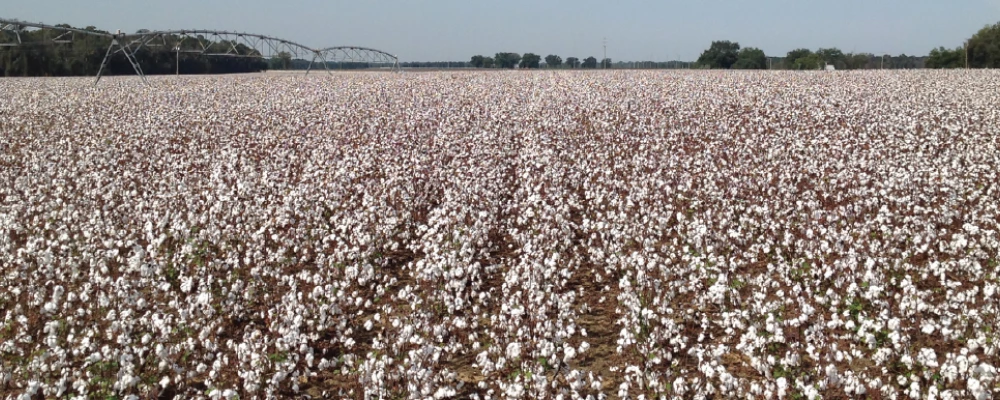
How Much Deforestation Is Your Cotton Creating?
This is a guest post from the founder and co-director of Satelligence who joined us for our Masterclass on Education As A Tool For Change. Looking holistically at topics is what we are all about in order to improve awareness and increase the guidance available to make practical changes within a business or lifestyle. So while you may not automatically consider cotton as a crop that can cause deforestation - with paper, viscose and meat being the biggest culprits in the eye of the conscious consumer - this article from Niels Wielaard will aid in your perspective of this fibre.
How Much Deforestation is Your Cotton Creating?
The shirt on your back, the sheets on your bed, the tent you pull out whilst camping. Cotton’s role within the textile industry is indispensable, with an immense number of materials made out of, or derived from it. Over 27 million tonnes of the commodity is produced each year with demand ever-increasing.
Whilst we are seeing more and more positive changes from retailers and consumers alike to make sustainable cotton the norm, production methods are in desperate need of reconfiguration. Switching to alternative, robust practices that actually contribute to the mitigation of environmental damage and climate change is the key to these changes.
Cotton’s environmental impact
For many years retailers and brands have struggled to address the severity of the very real impacts of cotton cultivation. The most critical concern is the significant overconsumption of water. To make just 1 kilogram of conventionally-produced cotton (i.e. with irrigation and overhead sprayers) you need 10,000 litres of water. Furthermore, the fabric that unassumingly contributes to the majority of our wardrobes, occupies just 2.4 per cent of the world’s agricultural land, yet accounts for 24 percent of the world’s insecticide market and 11 percent of the sale of global pesticides according to WWF.
Many people are horrified by the record-breaking deforestation and fires ripping through the Amazon, but few realise that the world’s largest amount of sustainably certified Better Cotton is coming from Brazil. Cotton is typically planted as the second crop of the season after soybeans have been harvested on the same field. Just how much deforestation, fire and carbon emission is actually associated with cotton? We’ll never know for sure unless we have the desire and the means to check - and that’s what we appear to have been lacking - until now.
While cotton is in the unsustainable hot seat, it is not to say other commodities are exonerated. Other raw materials for fashion, including fibres such as rayon and viscose, cardboard and paper for packaging, leather and rubber are, too, in desperate need of demonstrating truly environmentally friendly production.
The spotlight on sustainable sourcing at scale
Household names like Marks & Spencer, Stella McCartney and Ted Baker are among 45 major retailers that recently committed to ending deforestation within their supply chains. However, the current system of sustainability ratings and certificates used to mark deforestation free materials are themselves coming under criticism for being poorly implemented. Destruction: Certified, Greenpeace’s latest condemnation of traditional certifications like FSC, PEFC and the Rainforest Alliance has forced us to look more critically at what we really mean when we say “sustainable fashion.”
Consequently, retailers face a difficult challenge in ensuring the sustainability claims they make for their products are credible. Consumer demand sparked a new focus, where companies’ efforts to scrutinise their own commitments to sustainability are being called into question.
Satellites offer a chic new solution to monitoring sustainability credentials. Perfectly positioned with a birds eye view of the earth, satellites are a source of impartial, comprehensive, and quickly accessible insight for companies into their supply chains. Combined with farm ownership information, a new level of accountability is unlocked. The fashion industry can identify where cotton is grown, who produces it and how much of it is related to water stress in sourcing areas with precision and objectivity. Deforestation activity can be flagged as it happens, while quantifying and monitoring carbon and greenhouse gas emissions.
Utilising these modern approaches, the fashion industry can back up its claims of sustainability and ensure those shirts, sheets, and tents are sustainably produced and sourced.
Retailers are empowered to start taking ownership of the environmental risks in their supply chains with full transparency, and reliable data to hand. This helps them to avoid seeing their supply chain strategy come apart at the seams and suffer continued accusations of being all mouth, and no trousers.
About Niels Wielaard
Niels is founder and co-director of Satelligence, determined to make a meaningful impact measuring progress with satellite-based analytics with a focus on more sustainable agri-commodities. Niels received his MSc in Forestry with a specialization in geospatial information systems and remote sensing from Wageningen University in 2003. He is an expert on national forest monitoring systems in tropical forest countries and he was a technical advisor to the European Commission on satellite monitoring issues related to the implementation of the EC Renewable Energy Directive.
Follow on lessons:
Fashion production and its impact on deforestation [Satelligence]
Key issues of cotton production [The Sustainable Fashion Collective]
Conventional and sustainable cotton supply chains [Supreme Green Cotton®]
Thumbnail image: www.cottonfarming.com
